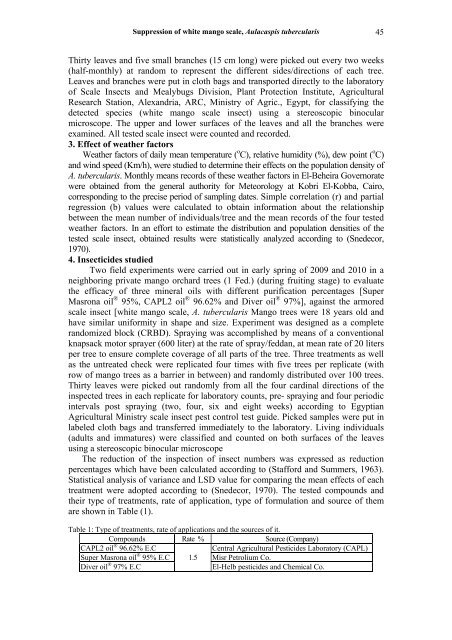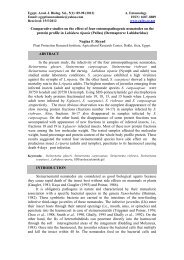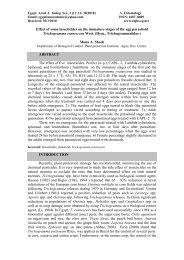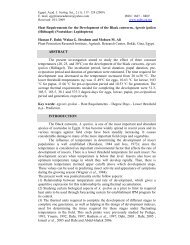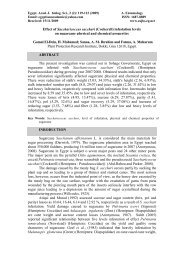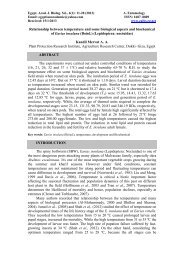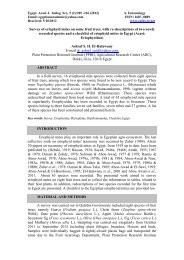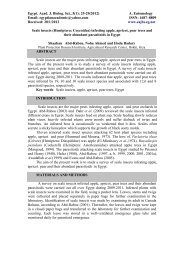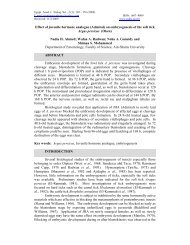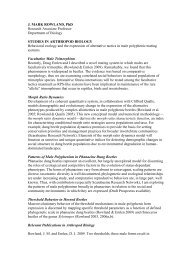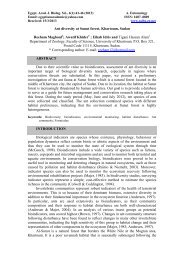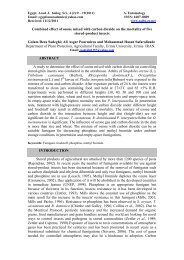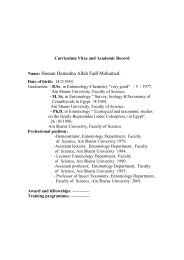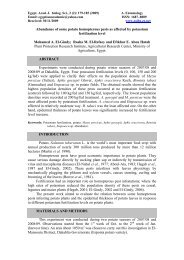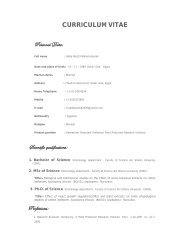Suppression of white mango scale, Aulacaspis tubercularis ...
Suppression of white mango scale, Aulacaspis tubercularis ...
Suppression of white mango scale, Aulacaspis tubercularis ...
Create successful ePaper yourself
Turn your PDF publications into a flip-book with our unique Google optimized e-Paper software.
<strong>Suppression</strong> <strong>of</strong> <strong>white</strong> <strong>mango</strong> <strong>scale</strong>, <strong>Aulacaspis</strong> <strong>tubercularis</strong> 45<br />
Thirty leaves and five small branches (15 cm long) were picked out every two weeks<br />
(half-monthly) at random to represent the different sides/directions <strong>of</strong> each tree.<br />
Leaves and branches were put in cloth bags and transported directly to the laboratory<br />
<strong>of</strong> Scale Insects and Mealybugs Division, Plant Protection Institute, Agricultural<br />
Research Station, Alexandria, ARC, Ministry <strong>of</strong> Agric., Egypt, for classifying the<br />
detected species (<strong>white</strong> <strong>mango</strong> <strong>scale</strong> insect) using a stereoscopic binocular<br />
microscope. The upper and lower surfaces <strong>of</strong> the leaves and all the branches were<br />
examined. All tested <strong>scale</strong> insect were counted and recorded.<br />
3. Effect <strong>of</strong> weather factors<br />
Weather factors <strong>of</strong> daily mean temperature ( o C), relative humidity (%), dew point ( o C)<br />
and wind speed (Km/h), were studied to determine their effects on the population density <strong>of</strong><br />
A. <strong>tubercularis</strong>. Monthly means records <strong>of</strong> these weather factors in El-Beheira Governorate<br />
were obtained from the general authority for Meteorology at Kobri El-Kobba, Cairo,<br />
corresponding to the precise period <strong>of</strong> sampling dates. Simple correlation (r) and partial<br />
regression (b) values were calculated to obtain information about the relationship<br />
between the mean number <strong>of</strong> individuals/tree and the mean records <strong>of</strong> the four tested<br />
weather factors. In an effort to estimate the distribution and population densities <strong>of</strong> the<br />
tested <strong>scale</strong> insect, obtained results were statistically analyzed according to (Snedecor,<br />
1970).<br />
4. Insecticides studied<br />
Two field experiments were carried out in early spring <strong>of</strong> 2009 and 2010 in a<br />
neighboring private <strong>mango</strong> orchard trees (1 Fed.) (during fruiting stage) to evaluate<br />
the efficacy <strong>of</strong> three mineral oils with different purification percentages [Super<br />
Masrona oil ® 95%, CAPL2 oil ® 96.62% and Diver oil ® 97%], against the armored<br />
<strong>scale</strong> insect [<strong>white</strong> <strong>mango</strong> <strong>scale</strong>, A. <strong>tubercularis</strong> Mango trees were 18 years old and<br />
have similar uniformity in shape and size. Experiment was designed as a complete<br />
randomized block (CRBD). Spraying was accomplished by means <strong>of</strong> a conventional<br />
knapsack motor sprayer (600 liter) at the rate <strong>of</strong> spray/feddan, at mean rate <strong>of</strong> 20 liters<br />
per tree to ensure complete coverage <strong>of</strong> all parts <strong>of</strong> the tree. Three treatments as well<br />
as the untreated check were replicated four times with five trees per replicate (with<br />
row <strong>of</strong> <strong>mango</strong> trees as a barrier in between) and randomly distributed over 100 trees.<br />
Thirty leaves were picked out randomly from all the four cardinal directions <strong>of</strong> the<br />
inspected trees in each replicate for laboratory counts, pre- spraying and four periodic<br />
intervals post spraying (two, four, six and eight weeks) according to Egyptian<br />
Agricultural Ministry <strong>scale</strong> insect pest control test guide. Picked samples were put in<br />
labeled cloth bags and transferred immediately to the laboratory. Living individuals<br />
(adults and immatures) were classified and counted on both surfaces <strong>of</strong> the leaves<br />
using a stereoscopic binocular microscope<br />
The reduction <strong>of</strong> the inspection <strong>of</strong> insect numbers was expressed as reduction<br />
percentages which have been calculated according to (Stafford and Summers, 1963).<br />
Statistical analysis <strong>of</strong> variance and LSD value for comparing the mean effects <strong>of</strong> each<br />
treatment were adopted according to (Snedecor, 1970). The tested compounds and<br />
their type <strong>of</strong> treatments, rate <strong>of</strong> application, type <strong>of</strong> formulation and source <strong>of</strong> them<br />
are shown in Table (1).<br />
Table 1: Type <strong>of</strong> treatments, rate <strong>of</strong> applications and the sources <strong>of</strong> it.<br />
Compounds Rate % Source (Company)<br />
CAPL2 oil ® 96.62% E.C<br />
Central Agricultural Pesticides Laboratory (CAPL)<br />
Super Masrona oil 1.5<br />
® 95% E.C Misr Petrolium Co.<br />
Diver oil ® 97% E.C El-Helb pesticides and Chemical Co.


